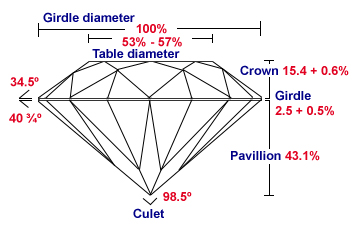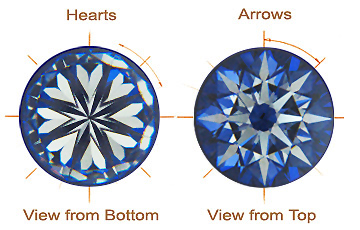Your Online Source for Wholesale Diamonds


The GIA Cut Scale ranges from Excellent to Poor and they provide a cut quality grade for standard round brilliant diamonds that fall in the D-to-Z color range. A polished diamond's beauty lies in its complex relationship with light:
The result of the complex relationship with light is a magnificent display of three attributes. Brightness is the combination of all white light reflecting from the surface and interior of a diamond. Fire describes the "flares" of color emitted from a diamond. Scintillation describes the flashes of light you see when the diamond, the light or when the observer moves.

A polished diamond's proportions affect its light performance, which in turn affects its beauty and overall appeal. Diamonds with fine proportions, symmetry and polish optimize their interaction with light, and have increased brightness, fire and scintillation.
Learn about Hearts and Arrows
DiamondonNet Ideal Princess Cut

Each DiamondonNet Ideal Princess Cut diamond has exact proportions, and is certified to have a length-to-width ratio no greater than 1.05. The DiamondonNet Ideal Princess Cut diamond features a longer crown height that is almost twice the normal height that the industry is producing. The light can be absorbed more if the crown is higher, while the exquisite polish and symmetry enable the facets to display maximum brilliance. With its smaller table and precise symmetry, the DiamondonNet Ideal Princess Cut diamond is able to return more light. Each diamond is engineered to maximize quality over size. While typical diamonds are cut to a depth of 88% or more, DiamondonNet Ideal Cut diamonds are cut to a depth of 70% or less, giving up approximately 7% carat weight to ensure higher quality.
DiamondonNet Ideal Emerald Cut

The major difference between the DiamondonNet Ideal Emerald Cut diamond and the standard emerald cut in the industry are the culet and higher crown. Also, DiamondonNet Ideal Emerald Cut diamond has outstanding proportions, symmetry, polish, maximum brilliance and ability to stop light from escaping. The brilliance is achieved by bigger crown facets which absorb more light, while the distribution of pavilion facets reflects more light. In addition, all DiamondonNet Ideal Emerald Cut diamonds have a guaranteed clarity of VS2 or better, so you can be assured that stones will be eye-clean.
DiamondonNet Ideal Asscher Cut

Only the finest chosen raw diamonds are cut to produce DiamondonNet Ideal Asscher Cut diamond to make sure of the precise proportions to get absolutely perfect length-to-width ratios. One of the major differences of DiamondonNet Ideal Asscher Cut diamond and the standard emerald cut in the industry is its wider corners. This perfect angle can capture more light from this eight corner as it reflect square pattern that product more brightness and sparkles. Also you will notice that the crown is about 10% higher than the standard diamond. It makes the table smaller and larger facets on the crown that capture and return more light. Another difference is having a cullet. "
Hearts and Arrows on DiamondonNet Ideal Round Cut

The term Hearts and Arrows is used to describe the figure that can be seen on the bottom and top of a round diamond with perfect symmetry and angles. The Hearts and Arrows effect is exist in all of DiamondonNet Ideal Round Cut Collection diamonds. When viewed under special magnification, the perfectly aligned facets of the DiamondonNet Ideal Round Cut diamond reveal the Hearts and Arrows pattern. From the bottom, eight absolute symmetrical hearts can be seen and, when viewed from the top, eight thoroughly uniform arrows can be seen. This shows how perfect and uniform each facet of a diamond which will have the maximum brilliance.
